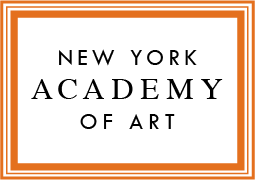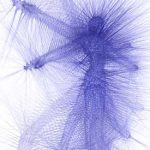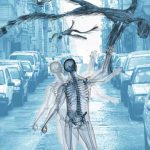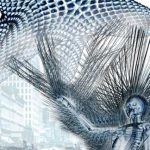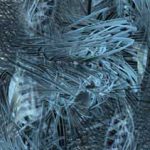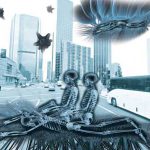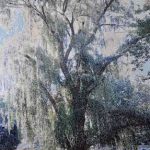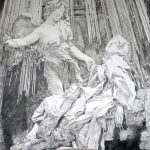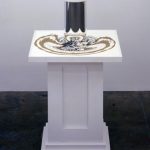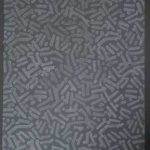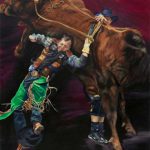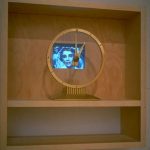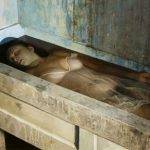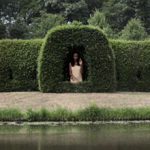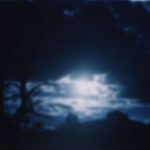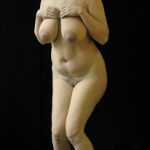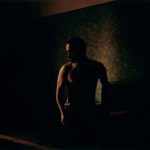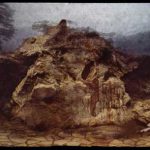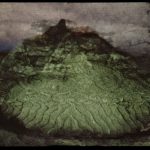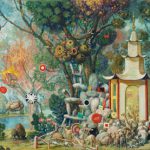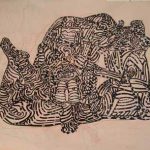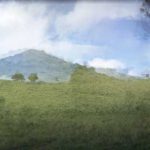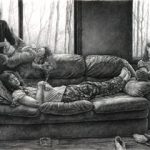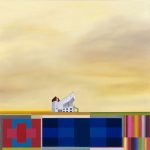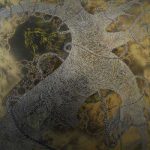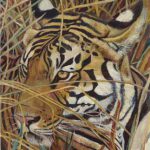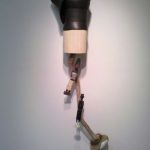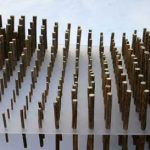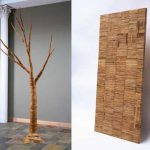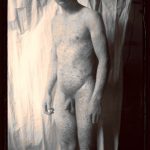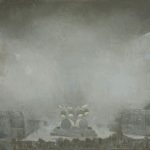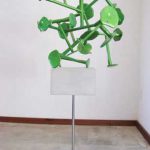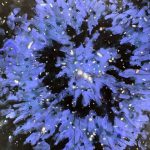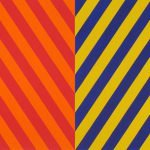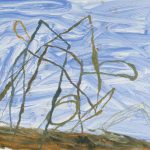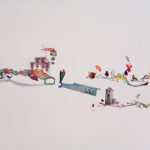Printmaxing!
by Aliene De Souza Howell (MFA 2011)
I started printmaking again last semester after years away from it.
Since taking the Narrative Printmaking Seminar, I started creating relief linocuts inspired from poetry. This acted as a significant catalyst in freeing up the imagery in my work. I felt I could get away with anything because of the graphic quality of the black and white and the finality of carving that lent a certain austerity to the image.
I’ve just started using animals as a lens to look at ideas of social practice and how, as humans, we’ve chosen to cultivate ourselves. I’ve always responded to the impact of life size work where you could really enter into the image and have always worked large in my paintings, so I thought I’d push my printmaking and began to work on a 36†x 60†image.
 |
| Printmaking instructor John Jacobsmeyer, Yi Cao, Post-Graduate Teaching Assistant Jan Pecarca and Aliene set the press. |
Due to its monstrous size, I needed assistance printing it. The press bed was maxed out and we even had to re-adjust it (a risky feat) and send the block back through the press a second time in order to print the entirety of the image. It worked out and I’ve just begun my second large print!
 |
| Pulling it off the press – a first look… |
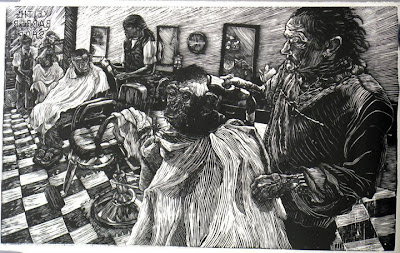 |
| The linocut, finished! |
Don’t miss the last Open House! March 19, 2011
March 19th, 2011
**Attendees will have their application fee reduced from $80 to $60! Please click here to register.
Facebook, Curator of Culture: Salon des Refusés
After the Academy posted a response on this blog to facebook’s removal of Steven Assael’s artwork (Jan 31, 2011, 5:22pm), The New York Times, Gawker, MSNBC, The Cornell Daily Sun, The Register, ARTINFO, and other news sources have covered this story. Please see below for photos facebook has removed from the Academy and Academy Alum’s accounts.
Where do you draw the line?
 |
|
Steven Assael, “Simone” ink on paper.
Artwork image removed by facebook, 1/31/2011
from the Academy’s “Uncovered” exhibition on facebook. |
 |
| Alyssa Monks, (MFA 2001) “Press” oil on canvas, 2008. Artwork image removed by facebook, 9/2010. Alyssa’s original facebook account was disabled. |
| Richard T. Scott (MFA 2007) “Hermetica” oil on canvas. Artwork removed by facebook, 1/30/2011 |
 |
| John Wellington (MFA 1990) “Break Clean From the Past” oil on aluminum. Artwork removed by facebook, 2/13/2011 (John has since posted “facebook-is-keeping-you-safe” censored images on his facebook page.) |
 |
|
Judy Fox, “Venus” 2004. Filled Resin, Casien 67 x 21 x 17 |
 |
| Gary Schneider, “Young Man, 1908, 2008” pigmented ink on paper, 52.5 x 38.5 in. Artwork removed by facebook, 2/22/2011 from the album of the Put Up or Shut Up exhibition. ________ NB: This image was removed from the Academy’s facebook page after this article was published in The New York Times. |
 |
| Patricia Cronin “Canto VI: Circle Three, The Gluttons” watercolor on paper, 60 x 40 in. Artwork removed by facebook, 3/1/2011
from the album of the Put Up or Shut Up exhibition.
________ NB: This image was removed from the Academy’s facebook page after the story was published in The New York Times
and also by many other news sources. |
 |
|
Artwork: Judy Fox, “Venus” 2004. Filled Resin, Casien 67 x 21 x 17
Article: The New York Times from the Has Your Artwork Been Removed By Facebook? album.
This album has been created to track artworks that have been
removed from the Academy’s page. The “offending” artworks appear
with text from articles posted by news sources reporting on
facebook’s censorship of artwork on the Academy’s page.
|
 |
| Well, folks, what do you think? |
 |
| And on the same day, current student Aleah Chapin’s facebook profile photo was removed as well. She reposted it, as seen here. |
August 12, 2011:
“The needs of many outweigh the needs of few…”
 |
|
Artwork: John Jacobsmeyer, “Planet New Hampshire” 2007. Oil on Canvas 36 x 36 in.
|
Studio Shots: Jon Beer, Jacob Hicks, Nicolas Holiber
I’m creating spaces and worlds where the past and present exist simultaneously.
“I’m focused on the meaning of my name – Jacob – which means ‘to supplant.’
I supplant my visage and personal narrative into the continuously
reproduced mythologies of Western culture.”
Winter Fever
A new year of art is upon us. Though it may have gotten off to a slow start; blame the blizzards, there are some exciting things on the horizon. So shovel yourself out of your winter doldrums and go see these shows.
 |
| Donald Judd |
Pace has several formidable artists currently showing; Tara Donovan is already open in Chelsea. The show features Donovan’s intricate drawings that are painstakingly rendered environments unto themselves. Donald Judd opens Thursday. Judd is arguably the the father of minimalist sculpture and is singlehandedly responsible for making Marfa, TX the art destination it is today. The show will focus on lesser known materials that Judd introduced into his work during the final decades of his life. Also look forward to Zhang Huan opening at the beginning of the March.
Also on Thursday night in Chelsea check out Academy alumni Jane La Farge Hamill, Caitlin Hurd, and Christian Johnson‘s take on the figure at their opening Aloft at J. Cacciola Gallery.
 |
| Hurd, Johnson and Hamill at J. Cacciola |
 |
| Richard Butler |
Richard Butler hypochondriacatthegramercyparkhotel opens Friday at Freight + Volume. The British artist/musician (Psychedelic Furs) paints hauntingly elegant portraits of coming of age youth with a minimalist palette and space reminiscent of Bacon. I am most seduced by the way he uses oil paint to depict surfaces like latex and bubble wrap when masking his subjects.
 |
| Robin Williams |
Also in Chelsea go see Robin William’s show The Rescue Party at P.P.O.W. William’s work is a little Yuskavage, a little Currin, and a little early Micah Ganske. It is not to be missed by anyone interested in current figuration.
In museum news, there is a mid-career retrospective of George Condo’s work that just opened at the New Museum. Condo’s work constantly borrows from the historical cannon of western art as he subverts old and new masters.
 |
| George Condo |
| David Wojnarowicz |
Finally, go see the Contemporary show at MoMA. There is a fantastic piece by everyone’s favorite censored artist, David Wojnarowicz. The show is an investigation on provocative artwork discussing economics, gender and ethnicity since the late 60’s.
Lecture: Jeanne Silverthorne
 |
| Jeanne Silverthorne, Nightshade, courtesy McKee Gallery |
Jeanne Silverthorne is an artist who lives and works in New York. She is best known for sculptures cast in rubber, but her installations often include photographs, videos and kinetic elements as well. She has exhibited at the Whitney Museum of Art, the Museum of Modern Art, the San Francisco Museum of Art, the Albright Knox Museum, among others, and her work is in the collections of those museums as well the Leum Samsung Museum, Korea, FINAC, Denver Museum, Weatherspoon Museum, Houston Museum, Sheldon Museum, the Contemporary Museum Honolulu, and the RISD Museum. She is represented by McKee Gallery in New York and Shoshana Wayne Gallery in Los Angeles. Reviews and articles about her work have appeared in Artforum, Art in America, Art News and Sculpture Magazine. A feature on her projects is scheduled to be published in a forthcoming issue of Sculpture Magazine. This year she has been awarded a Joan Mitchell Foundation Award. Since 1993, she has taught at the School of Visual Arts and for seven years she was on the faculty of the MFA program at Columbia University
All lectures are free and open to the public.
Watch the blog for upcoming lectures including Donald Kuspit & Phoebe Hoban.
Click here for a complete schedule of SPRING 2011 Lectures
The NYAA Library has these resources available exclusively for NYAA students.
Electronic access to Academic OneFile and GALEÂ (links only accessible in the NYAA campus):
- Neff, Eileen. “Jeanne Silverthorne: Institute of Contemporary Art.” Artforum International 35.2 (1996): 121+. Academic OneFile. Web. 14 Feb. 2011.
- Cotter, Holland. “ART IN REVIEW.” New York Times 13 Aug. 1999. Academic OneFile. Web. 14 Feb. 2011.
- Glueck, Grace. “Jeanne Silverthorne.” New York Times 12 May 2000: B34(N); E36(L). Academic OneFile. Web. 14 Feb. 2011.
- Johnson, Ken. “Jeanne Silverthorne.” New York Times 23 May 2003: E36. Academic OneFile. Web. 14 Feb. 2011.
- Frankel, David. “Jeanne Silverthorne: MCKEE GALLERY.” Artforum International 47.1 (2008): 459. Academic OneFile. Web. 14 Feb. 2011.
- Frankel, David. “JEANNE SILVERTHORNE.” Artforum International 38.5 (2000): 115. Academic OneFile. Web. 14 Feb. 2011
Fellows: John O’Reilly
While you’re in the middle of your Fellowship year, what do you find challenging and satisfying?
As a student getting ready to graduate, I had a specific line of thought I wanted to develop. Using the beginning of my fellowship year to “look inward,†I’ve been able to develop that strain of thought and also to “look outward†by seeing galleries and museums and other artists’ studios. Now I want to digest it all, react visually, and see how it adds to my original intent. My work explores “breath.†The intake, the absorption, the release… the pulse is getting stronger the breaths are getting deeper.
There are now so many “shadows†of ideas that are lingering and morphing into my work, I want to make more projects to elaborate… but the studio space I occupy is filling up quickly and I wish I had more area to create more work. I don’t want to discard anything I’ve started, but I have to – due to my space and time limitations (the Fellows’ Exhibition is coming up in September 2011) – be more selective about which themes I pursue.
| John in his studio at the Academy |
It’s a constant continuation and evolution. The more things I do, the more they inform each other and reveal a dialogue with myself. I find satisfaction in letting my intuition take over in the process. It becomes meditative where everything slows down and I’m able to sift through ideas and discoveries that manifest themselves in a physical object.

Put Up or Shut Up
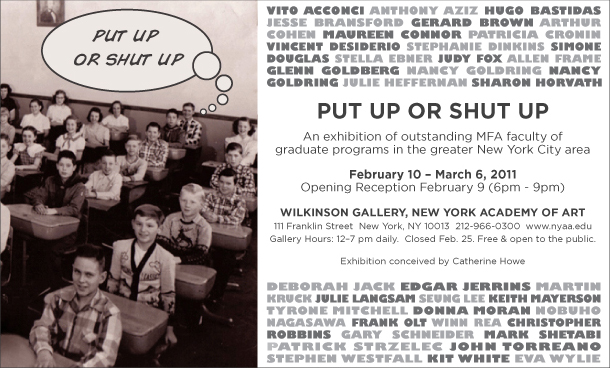
- Vito Acconci
- Vito Acconci
- Vito Acconci
- Vito Acconci
- Vito Acconci
- Anthony Aziz
- Hugo Bastidas
- Jesse Bransford
- Jesse Bransford
- Gerard Brown
- Arthur Cohen
- Maureen Connor
- Patricia Cronin
- Vincent Desiderio
- Stephanie Dinkins
- Simone Douglas
- Stella Ebner
- Judy Fox
- Allen Frame
- Glenn Goldberg
- Nancy Goldring
- Nancy Goldring
- Julie Heffernan
- Sharon Horvath
- Deborah Jack
- Edgar Jerrins
- Martin Kruck
- Julie Langsam
- Seung Lee
- Keith Mayerson
- Tyrone Mitchell
- Donna Moran
- Nobuho Nagasawa
- Frank Olt
- Winn Rea
- Christopher Robbins
- Gary Schneider
- Mark Shetabi
- Patrick Strzelec
- John Torreano
- Stephen Westfall
- Kit White
- Eva Wylie
College Art Association NY AREA MFA EXHIBITION
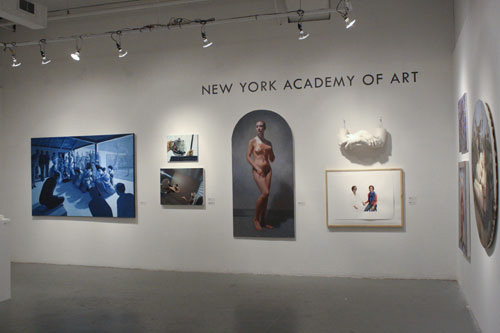
Participating Artists:
Emily Davis Adams
Kiley Ames-Klein
Elina Anatole
Corinne Beardsley
Demetrio Belenky
Ramona Bradley
Aleah Chapin
Diana Corvelle
Cara De Angelis
Alexandra Finkelchtein
Charlotte Foyle
Jeffrey Gipe
Jason Sho Green
Ian Healy
Adam LaMothe
Shanga Manning
Gary Murphy
Monica Olsen
Guno Park
Joseph Ventura
Tyler Vouros
Shawn Yu
From the distance of a map-maker
The recent talk of censorship in the arts has me thinking more about the relationship between map-maker and mapped; gardener and garden; artist and artwork.
 |
| US Department of Interior survey plat, New Mexico, 1880 |
As I develop my farmland images in paint (departing from my earlier works on photographs), I’ve been thinking more about the way maps feel. I get a sense of awe with the aerial view of farmland because what I see vacillates between map and fields. In the true-to-form representation of the landscape as photograph or painting, the image may still be read as non-objective.
 |
| (Developing farmland in oil paint, stage II) |
It it is interesting to me how the distance between the map-maker and the thing mapped, the dissociation of the person from the place or thing they are arranging, allows for a relationship in which the subject is a non-objective thing to the map-maker. Some contemporary voices note the violence that can arise from this distance; that the agricultural policies and practices responsible for the farm-grids are violent, environmentally and socially; that there was violence in the homesteading maps, violence in the reservation mapping, violence in Indian assimilation policies (the mapping of one culture’s visual presentation onto another)*.
